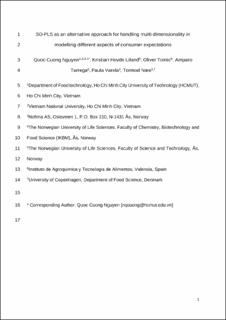| dc.contributor.author | Nguyen, Quoc Cuong | |
| dc.contributor.author | Liland, Kristian Hovde | |
| dc.contributor.author | Tomic, Oliver | |
| dc.contributor.author | Tarrega, Amparo | |
| dc.contributor.author | Varela-Tomasco, Paula Alejandra | |
| dc.contributor.author | Næs, Tormod | |
| dc.date.accessioned | 2020-11-19T12:33:23Z | |
| dc.date.available | 2020-11-19T12:33:23Z | |
| dc.date.created | 2020-07-27T10:52:34Z | |
| dc.date.issued | 2020 | |
| dc.identifier.citation | Food Research International. 2020, 133 . | en_US |
| dc.identifier.issn | 0963-9969 | |
| dc.identifier.uri | https://hdl.handle.net/11250/2688718 | |
| dc.description.abstract | In the development of sensory and consumer science, data are often collected in several blocks responding to different aspects of consumer experience. Sometimes the task of organizing the data and explaining their relation is non-trivial, especially when considering structural (casual) relationship between data sets. In this sense, PLS path modelling (PLS-PM) has been found as a good tool to model such relations, but this approach faces some issues regarding the assumption of uni-dimensionality of consumers’ data blocks. Sequential Orthogonalised PLS path modelling (SO-PLS-PM) has been proposed as an alternative approach to handle the multi-dimensionality and to explain the relations between the original data blocks without any preprocessing of the data. This study aims at comparing the efficacy of SO-PLS-PM and PLS-PM (together with splitting blocks into uni-dimensional sub-blocks) for handling multi-dimensionality. Data sets from two satiety perception studies (yoghurt, biscuit) have been used as illustrations. The main novelty of this paper lies in underlining and solving a major, but little studied problem, related to the assumption of one-dimensional blocks in PLS-PM. The findings from the comparisons indicated that the two approaches (PLS-PM and SO-PLS-PM) highlighted the same main trends for the less complex samples (yoghurt samples): liking was the essential driver of satiation perception and portion size selection; while satiation mainly predicted satiety perception. For the more complex data set - from a sensory perspective - (biscuit samples), the relations between data blocks in PLS-PM model was difficult to interpret, whereas they were well explained by SO-PLS-PM. This underlines the ability of SO-PLS-PM to model multi-dimensional data sets without requiring any preprocessing steps. | |
| dc.language.iso | eng | en_US |
| dc.subject | Satiety | |
| dc.subject | Satiety | |
| dc.subject | Liking | |
| dc.subject | Liking | |
| dc.subject | Consumers | |
| dc.subject | Consumers | |
| dc.title | SO-PLS as an alternative approach for handling multi-dimensionality in modelling different aspects of consumer expectations | en_US |
| dc.type | Peer reviewed | en_US |
| dc.type | Journal article | en_US |
| dc.description.version | acceptedVersion | |
| dc.source.pagenumber | 13 | en_US |
| dc.source.volume | 133 | en_US |
| dc.source.journal | Food Research International | en_US |
| dc.identifier.doi | 10.1016/j.foodres.2020.109189 | |
| dc.identifier.cristin | 1820570 | |
| dc.relation.project | Norges forskningsråd: 262308 | |
| cristin.ispublished | true | |
| cristin.fulltext | postprint | |
| cristin.qualitycode | 1 | |
